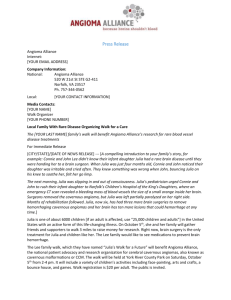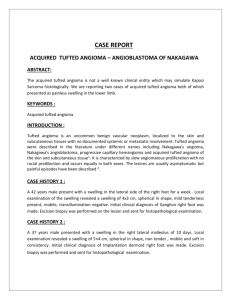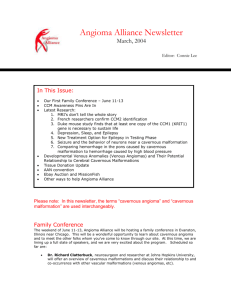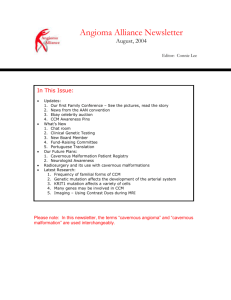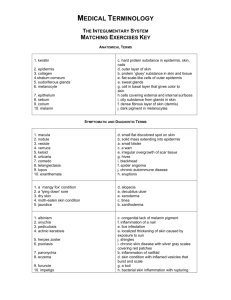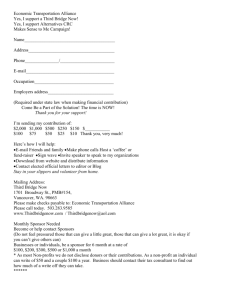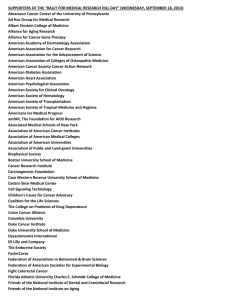Living with Brainstem Cavernous Angioma
advertisement
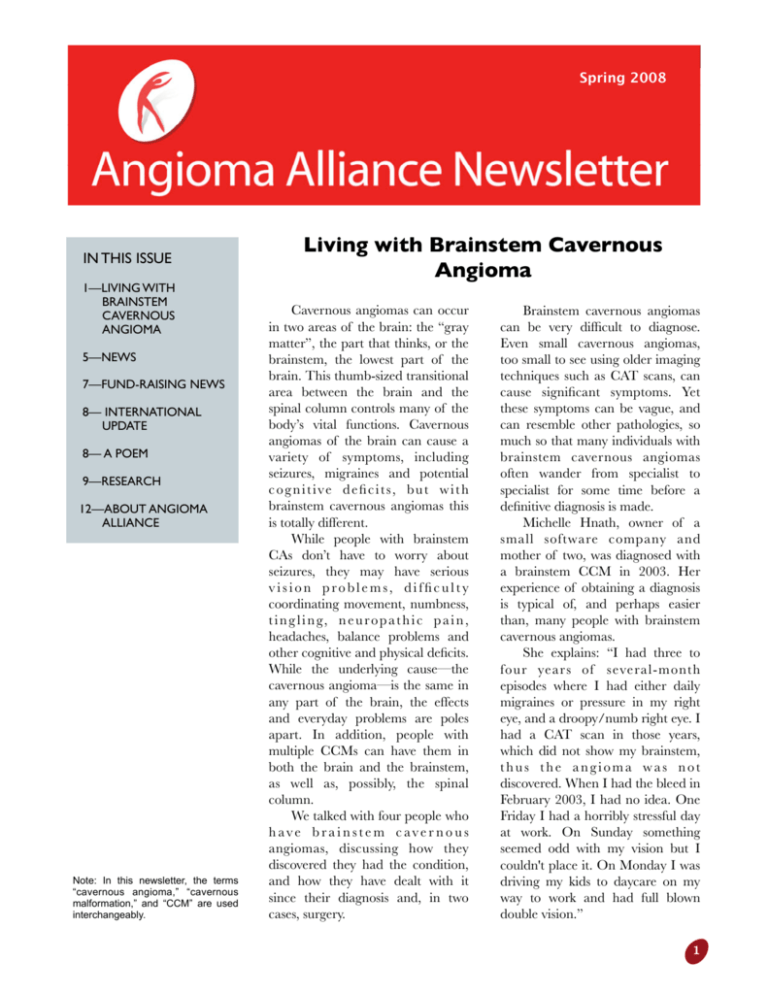
ANGIOMA ALLIANCE NEWSLETTER SPRING 2008 Spring 2008 IN THIS ISSUE 1—LIVING WITH BRAINSTEM CAVERNOUS ANGIOMA 5—NEWS 7—FUND-RAISING NEWS 8— INTERNATIONAL UPDATE 8— A POEM 9—RESEARCH 12—ABOUT ANGIOMA ALLIANCE Note: In this newsletter, the terms “cavernous angioma,” “cavernous malformation,” and “CCM” are used interchangeably. Living with Brainstem Cavernous Angioma Cavernous angiomas can occur in two areas of the brain: the “gray matter”, the part that thinks, or the brainstem, the lowest part of the brain. This thumb-sized transitional area between the brain and the spinal column controls many of the body’s vital functions. Cavernous angiomas of the brain can cause a variety of symptoms, including seizures, migraines and potential c o g n i t i v e d e fi c i t s , b u t w i t h brainstem cavernous angiomas this is totally different. While people with brainstem CAs don’t have to worry about seizures, they may have serious v i s i o n p r o b l e m s , d i f fi c u l t y coordinating movement, numbness, t i n g l i n g, n e u r o p a t h i c p a i n , headaches, balance problems and other cognitive and physical deficits. While the underlying cause—the cavernous angioma—is the same in any part of the brain, the effects and everyday problems are poles apart. In addition, people with multiple CCMs can have them in both the brain and the brainstem, as well as, possibly, the spinal column. We talked with four people who have brainstem caver nous angiomas, discussing how they discovered they had the condition, and how they have dealt with it since their diagnosis and, in two cases, surgery. Brainstem cavernous angiomas can be very difficult to diagnose. Even small cavernous angiomas, too small to see using older imaging techniques such as CAT scans, can cause significant symptoms. Yet these symptoms can be vague, and can resemble other pathologies, so much so that many individuals with brainstem cavernous angiomas often wander from specialist to specialist for some time before a definitive diagnosis is made. Michelle Hnath, owner of a small software company and mother of two, was diagnosed with a brainstem CCM in 2003. Her experience of obtaining a diagnosis is typical of, and perhaps easier than, many people with brainstem cavernous angiomas. She explains: “I had three to four year s of several-month episodes where I had either daily migraines or pressure in my right eye, and a droopy/numb right eye. I had a CAT scan in those years, which did not show my brainstem, thus the angioma was not discovered. When I had the bleed in February 2003, I had no idea. One Friday I had a horribly stressful day at work. On Sunday something seemed odd with my vision but I couldn't place it. On Monday I was driving my kids to daycare on my way to work and had full blown double vision.” 1 ANGIOMA ALLIANCE NEWSLETTER SPRING 2008 “A week later my right arm started to tingle. The next day my entire right side started to get tingly as I headed in for my MRI that identified my brainstem cavernous angioma. By a week later, my right side was totally numb, scalp to toes.” Vern Daniel is a 33-year-old father of two who has multiple brainstem cavernous angiomas. His road to diagnosis was somewhat unusual: “In 2004, I was a mechanic. I had a mobile fleet service. I went around and worked on step vans for companies like Aramark and Fedex. I also took jujitsu classes and spent a lot of time fighting. I was progressing well in jujitsu—at that time, I was beating up more than I was getting beat up. In July, I got hit in the head with a drive shaft when I was working under a truck. I went to my family doctor. He said, ‘Let’s get a CAT scan to see if your skull is cracked.’ When he got it, he told us that he had good news and bad news. He said, ‘Your skull is not cracked, but you have this thing called a hemangioma. You need to go find a neurosurgeon.’ The neurosurgeon took the CAT scan and said that where the hemangioma is located, it would be too hard to get to. He explained that since they found it by accident and it wasn’t bothering me, I shouldn’t do anything about it. He told me to go ahead and take a month off of work and let my head heal. I went back to work and thought nothing of it.” Charmean Neithart is an interior designer and mother of three who received her diagnosis only after being told she had a stroke during a pregnancy and then insisting on increasingly higher quality MRI’s over the course of three years. When Charmean was asked how she felt when she heard her diagnosis, she said, “Initially it was a little of a relief in an odd way. I had been told for 3 years that it was a stroke, but I knew different. It was an odd sort of validation. When I found out, I wanted as much information as possible because it gives me some semblance of control. When I don’t know what is happening, I get anxiety. I became pro-active. Fear started to kick in only when I did go to my surgeon’s office. Always from the second I knew it was there, I wanted it gone.” Not everyone is this lucky, though. Many people go through a long process of diagnosis and misdiagnosis before finally finding out the cause of their problems. For a long time—before the advent of MRIs—many people with brainstem CAs were told they had multiple sclerosis, a degenerative disease, and many of them were medicated as though they had this disease. Only now that MRIs are common can brainstem cavernous angiomas be detected, and only if the appropriate types of scans are performed. (See more about the types of MRIs used to detect cavernous angiomas on this page on the Angioma Alliance web site: http://www.angiomaalliance.org/ imaging.html) Diagnosis is Only the Beginning After Michelle’s diagnosis, her hemorrhage continued. She says, “I was most surprised I wasn’t going into surgery immediately—my thought was, ‘you mean you can’t fix me?’ Each week for 6 weeks I got new and worsening symptoms. In addition to the numb right side, my left eye turned in all the way to my nose causing double vision. I had extreme exhaustion where I was in bed 20 hours a day but I was unable to sleep. I lost my balance, had memory impairment, etc. My parents moved in for 6 weeks at the time of the bleed to take care of the kids and me. I was never admitted to the hospital since they knew what it was from the MRI and didn’t feel they could do anything for me. At the 6-week mark, I noticed that I had a slight feeling that my balance was coming back. From that point on, I got better each week and was pretty decent 6 months later except cognitive deficits and numbness which were the slowest things to come back. During those weeks I had physical therapy, vision therapy and prism glasses to help my eyes focus together.” While not everyone with a brainstem cavernous angioma experiences a major hemorrhage, many do. Brainstem caver nous angiomas have more documented bleeds than cavernous angiomas in other areas of the brain, although this may be because even small bleeds can cause devastating symptoms. Symptoms of a bleed are usually progressive, but bleeds can continue, causing symptoms to worsen. Vern’s major hemorrhage came several years after his diagnosis. Vern states, “My earliest recollection of symptoms was December 20, 2006. I was dizzy for a few days before that—I thought I had an ear infection. I was driving to a job and I thought for just a split second that my vision went double. Then, for sure, on the 23rd of December, my vision did go double and it stayed that way. On Christmas Eve ‘06 I went to the ER because my vision was stuck double and it was really bad. I still thought I had an ear infection. Thinking back, I had other things that were probably symptoms before I had the double vision. I noticed tingling and some numbness on the left side of my body. I was seeing a lot of stars. I had a headache 2 ANGIOMA ALLIANCE NEWSLETTER SPRING 2008 that kind of wouldn’t go away. I thought all of this was from jujitsu fighting. And, I was very fatigued all the time. By the time I got to the ER, my walking was very bad—I was dragging my left foot. I told them I had the hemangioma. They did a CAT scan and they said nothing had happened. They gave me a shot of pain killers and sent me home and told me to go see an ophthalmologist.” “Instead, my wife got me an appointment with a neurologist, and he brought me in and ran me through a gamut of tests. He said I needed to get an MRI and it needed to be done that day. He didn’t say what he thought might be wrong. Once I read the report of the MRI, it said he ordered the MRI because he thought I had a stroke. Anyway, when they read the MRI results, it said I had numerous cavernous angiomas and some of them had bled.” “I did get a second opinion. Sometime in April we got into Johns Hopkins—they said there was no surgical option. Also, I’ve got a venous angioma that’s pretty large that they said they could not touch. They said the reason they could not do the surgery is that these angiomas are so deep in my brainstem, and they are all by my involuntary muscle controls.” Choosing Surgery Surgery for brainstem cavernous angiomas is not always an option. Since the brainstem is essentially a bundle of “eloquent” nerve fibers—eloquent is the term neurologists use to say that any damage to a specific area will cause irreparable harm—it can be difficult or impossible to envision surgery. In most cases, brainstem CAs can only be removed if they touch the outside of the brainstem, or if a bleed causes them to separate the outer fibers of the brainstem, allowing surgeons to get to them without cutting anything. Making a decision to have surgery in the brainstem, even when one is told that one is a candidate, can be excruciatingly difficult. Patients must place absolute trust in their surgeon. Most often, surgery is attempted only when the brainstem cavernous angioma becomes life threatening or symptoms have become debilitating. Rivky Ludzker is a mother of two young children who was diagnosed with a brainstem cavernous angioma early in 2006. She writes: “I was in a very dangerous situation because another hemorrhage could be fatal and surgery to remove it was very risky.” Even after carefully selecting a surgeon, things may not always go as hoped. For Rivky, “My surgeon successfully removed my cavernous angioma without damaging any surrounding nerves, but due to the stress and trauma to the area, I suffered from hemiparesis [weakness] on my left side and my double vision was much worse than before the surgery. I also felt constant spinning in my head that there was no relief from. I don’t remember much of my stay in Arizona. All I know is that I cried and cried.” Charmean shared, “At first, I was told by my surgeon that I did not meet the protocol for surgery. It had been years since the bleed and nothing new had happened to the cavernous angioma. Not having surgery didn’t sit well with me at all. But two weeks after that initial appointment, I had a second bleed and was admitted. I was given Decadron and waited five days until my surgeon came back in town. I was pretty much at peace with the surgery—I prayed the whole time and had other people praying for me. I focused on living and getting back to my routine. I never thought about the possible bad outcomes.” For some, a return to daily life happens quickly. At discharge, Charmean says, “I had vision problems, my balance was off, and I had lost a lot of weight. I had so many people around me—my husband, my coworkers, and people from my children’s school. I didn’t think about this being a tough road. I was more social than recuperating, but I think this actually helped me recover.” Charmean’s deficits resolved quickly and she was back at work within six weeks of discharge from the hospital. Now, five months after the surgery, she is back to all of her regular activities. For others, recovery from surgery is often long and difficult. Rivky’s surgery was followed by a fourmonth stay in an inpatient rehabilitation facility. Rivky’s life after surgery has required many changes. She cannot care for her children on her own, walks with a cane, and uses a wheel spinner to drive with one hand. At times this has felt overwhelming. Living in the “Wait and See” Zone Those who have inoperable cavernous angiomas must learn to cope with both the physical and emotional impact of the disease over the long term. In addition, since most are inoperable, these people are told by their doctors to “wait and see”; monitor their CCMs with regular MRIs, but little more. Michelle says, “I have not had surgery because the cavernous angioma has always been dead center in my pons [the upper part of the brainstem] so it’s not surgically accessible. In the past 5 years, I have had a good number of suspected small re-bleeds when 3 ANGIOMA ALLIANCE NEWSLETTER SPRING 2008 my stress level gets too high or once for no real reason except possibly a horrendous reaction to a bee sting. When that happens, usually my face, eye, head, neck, arm and hand get numb, I get migraines, and I get very tired. This lasts 2-3 weeks and then I gradually go back to just having a numb hand again. The hemosiderin stain [iron that remains after the blood is reabsorbed] around my angioma on MRI is so large, small re-bleeds cannot be seen…which is why I say suspected small re-bleeds.” Vern continues to struggle with deficits. He says, “My vision is about 95% better—I’ve only got a little double vision in my peripheral vision on my right side. My walking is still bad—my gait is still off, I walk like a drunk. I have tingling and numbness on my left side. I have very bad headaches every day. I move a whole lot slower than I used to—now I’m the last in line with my family. I have a lot of dizziness. My feet and sometimes my hands feel like I’ve got a knife shoved in them. Also got a little bit of weakness in my left side— I had testing and my left hand is much weaker. I can’t drive—my reaction time is just not near what it needs to be to operate a vehicle safely. My dad is driving me around where I need to go. We have 15 acres here. I have a tractor, a small bulldozer, and a 4 wheeler that I can get out in. To be safe, I never take the 4 wheeler out of 1st gear.” Coming to Terms It can be hard to come to terms with the changes a brainstem cavernous angioma can bring, but those who participated in this story are finding ways to adapt and to reframe their new lives. Vern is having the hardest time right now. He says,” The four walls around me feel like they’re coming in. Right now, I’ve begun taking antidepressants, but they haven’t started working yet. As far as dealing with things, at first I was pretty glad to be alive. Now, I don’t really appreciate it as much because of all the life changes I’ve had to go through. The things that I felt were a pain to do—like carting around the kids—now I realize it wasn’t really as bothersome as I thought. I wish I could do all those things again. I do still hope that maybe one day I will be able to—I try to keep a positive attitude but some days it’s rough. I’ve still got a heartbeat. I’ve still got my family.” Michelle has made significant life changes as a result of her experiences. She says, “I have recovered well. My remaining symptoms are some numbness in my right hand, and minor cognitive issues like difficulty multi-tasking. I live a very normal life except that I quit my high-stress job, work only about 10-20 hours a week on a home software business, and am an at-home mom to my 10 and 12 year-old children. The software company could probably do much better if I put more effort into it, but my life seems much more peaceful if I hike, bike, kayak, dance and play each week. [Editor’s note: just last year, Michelle completed a 150-mile kayak trip.] I poured so much of me into that old job for a decade, there wasn't anything left for my husband or children. It was not a good way to live. After recovering from my 2003 big bleed, I made a conscious effort to work far less, reduce stress, exercise 4-5 days a week, and surround myself with positive, caring people. I'm 43 and enjoy life with no daily fears of bleeds or weight on my shoulders about that. I know in my heart if it happens badly again, I will heal again. I've done it before and I will do it again. I'm strong and cavernous angiomas in the pons rarely kill anyone, they just annoy us to death.” Charmean observes, “The enormity of what I went through didn’t hit me until February. I made it thru the holidays. Then the psychological part of what I went through started to kick in. I had a couple of panic attacks in February—I felt a little tweak in my head and I reacted with ‘What’s that? Could it be coming back?’ On my way to a client’s house, I was on the phone with a friend and I was crying. I finally understood how big it all was. When I went in to surgery, I had to kiss my kids good-bye. I had to sign papers to unplug the life support machines. All those things are really heavy and really scary and I went through it.” After sharing a story about an old acquaintance who called after her surgery and expressed how much she had affected his life, Charmean mused, “I always thought what I did as an interior designer was fluff, but I came to realize that the small things I do to help others feel good about themselves in simple human contact—that is my purpose. The little things we do that we don’t think have consequence are important. It’s important that we recognize and respect the gifts we have and use them. I didn’t expect to get this out of brain surgery. In a way, I’m grateful for this.” Brigid Guttmacher, a therapist who spoke at our last family conference said something to the effect of, “For those of you in this room, life will never go back to the old ‘normal’, but…it will go on.” Here’s to life…going on. Connie Lee & Kirk McElhearn 4 ANGIOMA ALLIANCE NEWSLETTER SPRING 2008 News First National Institute of Health co-sponsored meeting on CCM On March 13 and 14, more than 30 scientists from around the world met in Washington, DC, to discuss Vascular Malformations of the Brain with a focus on cerebral cavernous malformations (CCM) a n d a r t e r i ove n o u s m a l f o r m a t i o n s ( AV M ) . Presentations ranged from the most basic aspects of blood vessel formation to practical questions of how research can inform treatment decisions. The purpose of the meeting was to describe the current state of the art in CCM and AVM research and to identify major priorities for future research. At least two major priorities were identified. First, researchers need better mouse models for the disease. Currently, the only way they have to create mice that have CCM is to knock out both a CCM gene and a tumor suppressor gene. This leads to very sick, very short-lived mice that are only moderately useful for studies. Second, researchers need more studies documenting what they call “natural history”. This is the behavior of cerebral cavernous malformations in the context of all the variables in an individual’s life, taking into account other health issues, activities, or diet. This is work that Angioma Alliance assists with its DNA/Tissue Bank and Patient Registry. Once researchers have a better understanding of how cavernous malformations behave without a medical treatment, they can create criteria for measuring the effectiveness of a medication or other treatment. The NIH co-sponsored meeting was recorded and a paper will be written to summarize the proceedings. The paper will be submitted to major scientific journals for publication. C o n g r e s s m a n To m U d a l l Becomes Champion for Cavernous Angioma Research Congressman Tom Udall (D-NM) has taken several steps to raise awareness about cavernous angiomas in Washington. In early March, the Congressman used the opportunity of a Labor and Health subcommittee meeting at which Dr. Elias Zerhouni, the Director of NIH, was testifying, to express the importance of cavernous angioma research to the citizens of New Mexico. Congressman Udall asked why a recent grant proposal that received a very high score from the NIH’s peer review process was not funded. He is also introducing a House Resolution that will educate the rest of Congress on the significance of the illness. Finally, Congressman Udall is requesting that the 2009 NIH budget include a requirement that NIH report back to Congress the amount of money that had been spent on cavernous angioma research at the end of the fiscal year. Dozens of researchers meeting in Washington to discuss vascular malformations. 5 ANGIOMA ALLIANCE NEWSLETTER SPRING 2008 Tissue/DNA Bank Update The Angioma Alliance Tissue/DNA Bank continues to grow, particularly as we have begun receiving samples from the Barrow Neurological Institute’s Tissue Bank. Our BioBank has evolved to the point that the Duke University cavernous angioma research program has decided to end their direct recruitment of subjects; they will be relying entirely on the Angioma Alliance BioBank for pre-screened DNA and tissue samples. This is exactly the outcome we had hoped to achieve. In this time of very scarce resources, Duke can now put the tens of thousands of dollars they were investing annually in subject recruitment toward actual bench work. They have also been able to cite the resources available to them from our BioBank in their grant proposals as they seek additional funding. If you had surgery at St. Joseph’s Hospital in Phoenix in the last 3 years and would like to participate in our BioBank, please contact us at Biobank@AngiomaAlliance.org. We are also accepting donors who are scheduled for an upcoming surgery at any United States hospital or who have had surgery within the past 5 years. We are particularly interested in folks who have the hereditary form of the illness. In our efforts to find ever more cost effective ways to continue this program, the Angioma Alliance Board of Directors has decided to leave the Genetic Alliance BioBank cooperative and for m an independent Tissue/DNA Bank. We have learned a great deal from our experience with the cooperative and are grateful for the support they provided to our fledgling efforts. We expect no down time as we transition and plan to be fully independent by early May. New Mexico Awareness Santa Fe Councilwoman Karen Heldmeyer, a friend of Angioma Alliance, has continued to champion cavernous angioma awareness in the city. As a result of her efforts, the Santa Fe City Council passed a resolution calling for a “Cavernous Angioma Awareness Week” to be held later this year and annually thereafter. Joyce Gonzales, Dr. Leslie Morrison, and Connie Lee have been working with New Mexico Governor Bill Richardson’s office and the New Mexico Health Department to develop ways to increase physician knowledge of the illness throughout the State. Programs that are developed in New Mexico would become models that could be used in other states. Scientific Workshop Leads to Acceptance of Consensus Paper In 2006, Angioma Alliance Scientific Advisory Board member Dr. Rustam Al-Shahi Salman gave a presentation entitled “What is cavernous malformation haemorrhage: Lessons from a prospective, populationbased study in Scotland”. This presentation was a draft of an article developing a standardized definition for cavernous angioma “hemorrhage”. Although one might think this had already been defined, in actuality, each doctor and researcher was using his or her own personal definition. Depending on the doctor, a hemorrhage could be defined as broadly as any headache or limited to something as extreme as an MRI finding of a cavernous angioma having bled outside the lesion itself. This range in definitions often made comparing research results impossible. By standardizing the definition, researchers would be able to track the natural course of the illness and compare the efficacy of treatments against each other. Dr. Salman’s presentation led to the creation of a committee whose charge was to refine the definition to one that could be useful in both a clinical and research setting. This consensus paper was completed in January, 2008 and was just accepted for publication by the journal “Stroke”. Its authorship is listed as “Rustam Al-Shahi Salman FRCP, Issam Awad MD, Michel Berg MD, and Leslie Morrison MD on behalf of the Angioma Alliance Scientific Advisory Board”. Because the article has not yet been published, we cannot divulge the details here, but we are very proud that such an important work was born from our workshop. 6 ANGIOMA ALLIANCE NEWSLETTER SPRING 2008 Fund-Raising News Angioma Alliance Receives 2 UCB Pharma Grants MadoroM Auction a Huge Success: Angioma Alliance Receives $35,500 Angioma Alliance has been awarded two grants from pharmaceutical company UCB Pharma. We have received a grant of $17,500 to support the recently held Vascular Malformations of the Brain scientific meeting which Angioma Alliance cosponsored with the National Institute of Neurological Disorders and Stroke. We received a second $18,000 grant to support our Tissue/DNA Bank and Patient Registry. Specifically, these funds will go toward the transfer and genetic testing of samples from the Barrow Neurological Institute’s tissue bank. We wish to thank UCB Pharma for their continuing generous support of Angioma Alliance. This is the third year that Andy and Marissa Amador and Mike and Shawn Blom have sponsored a charity auction benefiting Angioma Alliance and Small Miracles, another foundation with roots in Bakersfield, California. These auctions have been held in conjunction with a party celebrating the annual release of their MadoroM wine. This year’s auction was expanded to include more than just wine–exciting trips and a Rolex watch were among the goodies that could be had. After the bidding was over, the grand total raised was $71,000 which was split evenly between the two charities. For Angioma Alliance, this is the largest fundraiser that has been held to date. The Amadors and the other attendees are challenging each other to raise $100,000 next year! Brainy Bowling On May 4th, five Brunswick bowling alleys in the greater Atlanta area will be the scene of charity bowling tournaments to benefit Angioma Alliance. Teams of four will compete to win prizes and raise pledges. We still need volunteers to help with this event. If you live in the Atlanta area or have friends or family who do, please let Anjoleen Baca know if you’d be willing to lend a hand. You can reach her at Anjoleen.baca@att.net. We are very grateful to Brunswick Bowling for their sponsorship–we hope it is successful enough to spread throughout the country and become our signature fundraising event. Donating Stock There is a new way to support Angioma Alliance: donating equities or mutual funds you own. Doing this gives you a double tax benefit: you do not pay capital gains taxes on the increase in value of the shares since your purchase and you receive the full charitable deduction for the value of the shares at the time of the transfer of ownership to Angioma Alliance. Please call us or consult your investment adviser for more information. Pampered Chef Member Rachel Hart and her sister Shayna Dunn are donating their proceeds from online Pampered Chef sales to Angioma Alliance. Angioma Alliance will receive 20% of the sale price of any item you buy. These are high quality kitchen products that make cooking fun. Please go to www.pamperedchef.com to view the Pampered Chef line of products, but DO NOT PLACE YOUR ORDER ONLINE. To benefit Angioma Alliance, please contact Rachel at rachel_hart10@live.com and she will give you ordering instructions. Giving to Angioma Alliance There are so many ways to help Angioma Alliance fulfill its mission. We have revised our “Make a Donation” page to list the options. You may be surprised to see that many require no direct financial investment on your part. Check it out at www.AngiomaAlliance.org/donate.html. 7 ANGIOMA ALLIANCE NEWSLETTER SPRING 2008 International Update Angioma Alliance UK News Spring is in the air and Angioma Alliance (UK) has new plans for its Forum on Saturday June 7, 2008. Those of you living in the USA are welcome to attend. Make it a once-in-a-lifetime trip and visit one of the world’s g reat cities. Reduced rate accommodation is available at the five-star Grange Holborn Hotel, the conference venue. The hotel’s normal rate in June is £250 per night. But for those attending the Angioma Alliance (UK) Forum, the price is “only” £84.25 plus VAT (17.5%) per night. You may want to look at the hotel’s website: www.grangehotels.com/grange_holborn_hotel/ index.htm (Note: the price is per room not per person so you can save money by sharing!) For further details, contact Ian Stuart at info@angiomaalliance.org.uk. There is no charge for attending the Forum. As reported in the last Angioma Alliance newsletter, funding for the 2008 Angioma Alliance (UK) Forum has come from The Batty Charitable Trust. The trust is a grant-making body whose income derives from gifts made by the estate of the late Christina Batty (otherwise known as Christina Foyle; this name is synonymous with books, in the UK). Angioma Alliance (UK) considers itself very fortunate to be associated with them. We have a fantastic line-up of speakers: Dr. Connie Lee, President, Angioma Alliance, will speak on Coping With Cavernoma; our Medical Adviser, Mr. Neil Kitchen, Consultant Neurosurgeon, National Hospital for Neurology and Neurosurgery, will make a provocative presentation entitled Cavernoma Surgery Resisting Temptation; Professor Awad is kindly taking the time to travel to London and talk on Clinical Updates And Research Advances on Cavernous Angioma; and finally Mr. Sabin, Consultant Neurosurgeon at the Royal London Hospital and Chair of the Medical Advisory Committee, London Gamma Knife Centre, will talk on Gamma Knife Radiosurgery For Cavernoma: The Emperor’s New Clothes? The board listened to members’ suggestions from last year. After a complimentary lunch (no charge for Angioma Alliance Forum participants) there will be four sessions where members will meet for structured but informal workshops. Sessions on Children and Cavernoma; Carers for those with Cavernomas; Brainstem Cavernomas and those with Long-term Cavernomas. The operation of Angioma Alliance (UK) is made smoother by new office space which we obtained last year. Staffed by a volunteer, it is big enough to have board meetings in. Most important Angioma Alliance (UK) has a new treasurer and board member: Jon Anderson, CFO for Barclays Commercial Banking. We are very glad that he has joined us. Ian Stuart A Poem This poem was written by Rivky Ludzker, featured in our cover story, about one and a half years after her surgery to remove a brainstem cavernous angioma. I finally feel Like a mother once more To my two precious children, That I so adore. Although there’s a lot, That I still cannot do. But that doesn’t matter, From my kids’ point of view. To them I’m just mommy, The way I should be, They don’t know any better, And my flaws they don’t see. I make boo boos better, With a hug and a kiss. And it works really well Because innocence is bliss. And when bed time arrives, Only mommy will do. No one’s as good, To them, that is true. When they want a nice treat, They come and ask me. Because I’m their mother, It’s simple you see. And they sure can sense it, they feel and they know, that I am their mother, and I love them just so. I may not be doing, The physical part. But mothering I am And that I do, with my heart. 8 ANGIOMA ALLIANCE NEWSLETTER SPRING 2008 Research Unraveling the Mysteries of Hemorrhage Researchers at Northwestern University have focused their research on the role of inflammation and the immune response in cavernous angioma behavior. Their work is exploring whether the immune response could play a role in or represent a potential marker of CCM lesion proliferation and hemorrhage or could otherwise contribute to how lesions behave. It is in the pilot stages, but appears to be a promising approach. Shenkar R, Shi C, Check IJ, Lipton HL, Awad IA. Concepts and hypotheses: inflammatory hypothesis in the pathogenesis of cerebral cavernous malformations. Neurosurgery. 2007 Oct;61(4):693-702. Shi C, Shenkar R, Batjer HH, Check IJ, Awad IA. Oligoclonal immune response in cerebral cavernous malformations. Laboratory investigation. J Neurosurg. 2007 Nov;107(5):1023-6. Understanding Proteins Researchers at the University of North Carolina Chapel Hill and University of Colorado have worked together to further define the relationship between the CCM1, CCM2, and CCM3 proteins and their function in the cell. They have been able to identify these proteins as being part of a larger protein system that is capable of interacting with the cytoskeleton and membrane phospholipids. Additional work in Grenoble, France, explores the interaction specifically of CCM1 (KRIT1) with microtubules and the plasma membrane. Hilder TL, Malone MH, Bencharit S, Colicelli J, Haystead TA, Johnson GL, Wu CC. Proteomic identification of the cerebral cavernous malformation signaling complex. J Proteome Res. 2007 Nov;6(11): 4343-55. Epub 2007 Sep 27. Béraud-Dufour S, Gautier R, Albiges-Rizo C, Chardin P, Faurobert E. Krit 1 interactions with microtubules and membranes are regulated by Rap1 and integrin cytoplasmic domain associated protein-1. FEBS J. 2007 Nov;274(21):5518-32. Incidental Findings Two journal articles have been published on incidental findings of CCM. The first is a reaction to the whole body MRI scanning of otherwise healthy individuals in the UK, US, and Japan as part of routine medical care. They conclude that such scanning should be limited to research because of its high frequency of discovering “incidentalomas”: vascular malformations like CCM, AVM, or aneurysms that will never cause clinical symptoms. Their argument is that the emotional upheaval and the risks associated with treating asymptomatic lesions probably outweigh any benefit derived. The second article deals with the issue of managing treatment if an incidental cavernous angioma is discovered in an individual who is enrolled in a research study. The paper recommends a set of standards for managing this information. First, researchers using brain scans as part of their study should anticipate incidental findings and a procedure for managing these should be laid out before the study is started. This information should be conveyed to subjects when they are consented into the study. Second, they encourage the use of a medical professional to interpret scans for those believed to have incidental findings and, possibly, to convey this information in both verbal and written form directly to the research subject. Finally, researchers must be sensitive to individuals who may be more adversely affected by this information–those with limited access to health care and health insurance, children, and those who already are medically compromised from another condition. Al-Shahi Salman R, Whiteley WN, Warlow C. Screening using whole-body magnetic resonance imaging scanning: who wants an incidentaloma? J Med Screen. 2007;14(1):2-4. Illes J, Kirschen MP, Edwards E, Bandettini P, Cho MK, Ford PJ, Glover GH, Kulynych J, Macklin R, Michael DB, Wolf SM, Grabowski T, Seto B. Practical approaches to incidental findings in brain imaging research. Neurology. 2008 Jan 29;70(5):384-90. Review. 9 ANGIOMA ALLIANCE NEWSLETTER SPRING 2008 Comparing CCM to AVM and DAVF The SIVMS study, a prospective populationbased study carried out in Scotland, published its latest set of findings. They examined the data comparing age and severity of hemorrhage for three different types of intracranial vascular malformations: b r a i n a r t e r i ove n o u s m a l fo r m at i o n s, d u r a l arteriovenous fistula, and cavernous malformations. They found that those with cerebral cavernous malformations presented with hemorrhage at a younger age, but were less handicapped by the bleed. Cordonnier C, Al-Shahi Salman R, Bhattacharya JJ, Counsell CE, Papanastassiou V, Ritchie V, Roberts RC, Sellar RJ, Warlow C; SIVMS Collaborators. Differences between intracranial vascular malformation types in the characteristics of their presenting haemorrhages: prospective, population-based study. J Neurol Neurosurg Psychiatry. 2008 Jan;79(1):47-51. Epub 2007 May 8. A New Founder Effect: CCM2 exon 2-10 Deletion Researchers at Duke University and in Italy have published a paper in which they demonstrate a newly identified CCM founder effect in the US population. The Duke University team had previously discovered that deletions of parts of the CCM2 gene represent a common cause of the illness. A new paper demonstrates that one particular deletion–that is, the deletion of exons 2-10, which is nearly the entire gene–is a common finding in the United States, but not in Italy. After additional genetic testing (haplotype analysis) of the samples from American families, it became clear that these families were related in the same way that those with the Common Hispanic Mutation originating in New Mexico are related. A common ancestor has not yet been found, but Angioma Alliance is working with the families and with Duke to gather genealogical data. Liquori CL, Penco S, Gault J, Leedom TP, Tassi L, Esposito T, Awad IA, Frati L, Johnson EW, Squitieri F, Marchuk DA, Gianfrancesco F. Different spectra of genomic deletions within the CCM genes between Italian and American CCM patient cohorts. Neurogenetics. 2008 Feb;9(1):25-31. New Textbook about Cavernous Malformations A new textbook has recently been published about cavernous malformations: Cavernous Malformations of the Brain and Spinal Cord, by Giuseppe Lanzino and Robert F. Spetzler, presents the state of the art in diagnosing, treating and operating on CCMs. The publisher describes it as follows: “This book presents a comprehensive overview of the basic science and current clinical knowledge on cavernous malformations of the brain and spinal cord. Cavernous Malformations of the Brain and Spinal Cord begins by covering general aspects of the disease, including the natural history, molecular biology, pathological processes, genetic basis, neuroradiology, and classification of cavernous malformations. Separate chapters then address the various types of cavernous malformations, thoroughly describing the clinical presentation and management approaches for each clinical situation. Incisive review of recent literature sheds light on topics of incidence, location, and outcomes.” This much-needed resource is the first book about cavernous malformations in fifteen years, following Dr. Issam Awad and Dr. Daniel Barrow's "Cavernous Malformations". This book can be purchased from the Thieme Medical Publishers (www.thieme.com) or from bookstores and online vendors. 10 ANGIOMA ALLIANCE NEWSLETTER SPRING 2008 Angioma Alliance Donors—Fourth Quarter 2007 Beacons ($5000+) Codman and Shurleff, Inc. Daniel J. Lawlor Charitable Foundation Leaders ($1000-$4999) Claire and Brad Brian Diana and James George Charmean and Robert Neithart Lorna Reichl The Wert Family Foundation Benefactors ($500-$999) Libby and Mel Davis Tom and Nancy McHugh The Rashkind Family Foundation San Joaquin Bit Service Ann Schlaak Community Builders ($250-$499) Troy and Naomi Demontmorency Daniel Engle Marcia Groth Heather Kurpiewski John and Connie Lee Allison and Ken Ruggles Partners ($100-$249) Katherine and David Barto Jeffrey and Julia Demichiel Amy Elliott Tony Gussio Judith Joyce Tammy and Joe Lovrich Virginia Peter Kimberly Randall Ken and Mary Reeb John and Eunice Wiley Supporters ($50-$99) Fred and Joan Adair Donna Arnaud Linda Fleger-Berman Ruth Ecker Ruta Gedmintas Miri Greidi Michelle and Steve Hnath Carol Hoffman Tom and Carolyn Hoyt Beth Kennedy Erin McRoberts MGM Voice Foundation Gayle and James Post Norma Villa Friends ($1-$49) Patrick and Gennie Alano Susan Aries George and Trudy Barron Anne Brouwer Christine Castellano Dolores Estrada Goodsearch.com Igive.com Lester and Marcia Grube Herbert and Clara Hagen Jeffrey Jin Laurel Last Maurice Lantier Laura Lee Nichole Martinez In honor of Anjoleen Baca Brandon Baca Jennifer Coyne In honor of Becky, Jay, Churchill, Billy, and Paris Lee and Michael Rashkind In memory of Jenae Gallegos Mark and Veronica Campos Andrea Pacheco Eloise Valverde Tom and Laura White In memory of Barbara May Hebard Mitch and Karen Asbury Jean and Carl Bolton Deandra Dickson Robin and Tom Hays Charlotte Herndon Virginia McClenney Mark and Sandra Sheffler Sandra Vandercook Dean and Cassie Alexandrou In honor of Bettina Bendzlowicz, Susan Taylor, and Margaret Weaver Jerry and Charlene Bowlin In honor of Heather Kurpiewski Linda Bonnar Sylvia and Anthony Diaz Daisy Tatum In honor of Jerry and Charlene Bowlin Bettina Bendzlowicz In honor of Connie Lee Ned Perry In memory of James Brink Mitch and Karen Asbury Butts Road Intermediate School Kristen Dehn Laura Hebard Charlotte Herndon Amy Jagemann Virginia McClenney Northwest Child Development Center Mary Schnorf Sandra Vandercook In honor of John and Connie Lee Angelika Prolog In memory of Alene Byers June Rochedieu In honor of Riley Cerabona Dominick Cerabona Janice Cerabona Pamela Kenney In honor of Lisle Cohen Shelley Berkowitz Robert and Sherry Burns Janeen Carlo Susie-Q Conklin Laura and Frederick Cribbins Nancy Davidson Maureen Heath David and Beverly Henry Stephen Kaylor Virginia Panlasigui Linda Poverny In honor of Cristina DeSalvo Stevenson William and Patricia DeSalvo In memory of Jack Ertola Mike and Cathy Ryan In honor of Julia Lee Mike and Sally Derrig Ruth Fraser Molly Lee In honor of Jake and Sam Neuman Brad and Rebecca Hogue In honor of Lee Rashkind Eugene and Mary Grady In honor of Allison Ruggles Sharon Conger John and Linda Corsi Diane Lansing Daniel and Joann Passeri Irene and Ronald Ruggles Michael and Sandra Schulte Jeffrey and Mary Jane Turner Mary and Wallace Varonko In honor of the Ryan family Supporters of Gymnastics Dreams In honor of Mark Seymour William Calloway In honor of Susan Sukalich Richard and Kimberly Rice In memory of Richard Taylor Nancy Taylor In honor of Kandance Weems-Norris Randall Gaboriault 11 ANGIOMA ALLIANCE NEWSLETTER SPRING 2008 Who We Are... Angioma Alliance Board of Directors Angioma Alliance is a non-profit, international, patient-directed health organization created by p e o p l e a f f e c t e d by c e r e b r a l c av e r n o u s malformations (CCM). Our mission is to inform and support individuals affected by CCM while facilitating improved diagnosis and management of the illness through education and research. We are monitored closely in our educational efforts by a Scientific Advisory Board comprised of leading cerebrovascular neurosurgeons, neurogeneticists, and neurologists. • • • • • • Angioma Alliance 142 West York Street, Suite 708 Norfolk, Virginia 23510 866-HEAL-CCM (Toll free) 757-623-0615 info@angiomaalliance.org www.angiomaalliance.org Connie Lee, Psy.D, President Ken Ruggles, Chair Karen Asbury, Treasurer Norma Villa, BSW, Secretary Kristen Dehn, MS, Director Amy Jagemann, MBA, Director Scientific Advisory Board • Issam Awad, MD, MSc, FACS, Northwestern University Feinberg School of Medicine, Chair • Jose Biller, MD, Loyola University Chicago Stritch School of Medicine • Eric Johnson, Ph.D. • Douglas Marchuk, Ph.D., Duke University Medical Center, Dept. of Molecular Genetics and Microbiology • Leslie Morrison, MD, University of New Mexico Medical School • Michel Berg, MD, University of Rochester Medical School • Rustam Al-Shahi Salman, MA, PhD, MRCP, Western General Hospital, Edinburgh, Scotland How You Can Help Your contributions will help fund conferences and forums, increase research, and enhance outreach and support efforts. Our pins, car decals and wristbands support the mission and growth of Angioma Alliance. Share these meaningful gifts with your friends and family. Each donation of $10 or more will come with a CCM lapel pin thank you gift. Our “little red guy” pin is a wonderful way to increase awareness of cerebral cavernous malformation (CCM), our little known illness. Increasing public awareness can go a long way toward increasing research funding and improving quality of life for those with cavernous angioma. Each pin comes with cavernous angioma business-size information cards that can be handed to anyone who might have questions. Angioma Alliance has its own magnetic car ribbon! These unique ribbons are the larger 3 1⁄2” x 8” size and are available for $5 each, including shipping. Educate while you travel! To donate or order Angioma Alliance merchandise, send a check or money order (using the enclosed envelope) or visit www.angiomaalliance.org and purchase all of your Angioma Alliance gear in one fast, easy transaction! You can donate and purchase using a credit card with our Paypal connection. The Angioma Alliance Newsletter is a quarterly publication of Angioma Alliance Editor: Kirk McElhearn, kirk@mcelhearn.com 12
